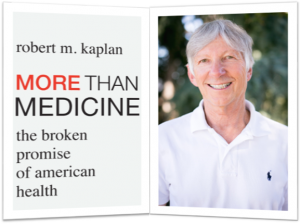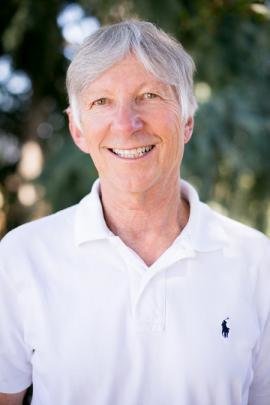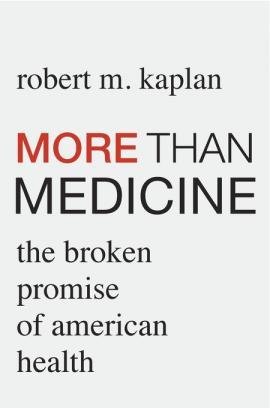
A 2015-16 CASBS fellow and renowned authority in healthcare and health services research, Robert M. Kaplan has forged a career combining scholarly excellence, leadership, and service matched by few.
He currently is director of research at Stanford Medical School’s Clinical Excellence Research Center. He is Distinguished Emeritus Professor of Health Services and Medicine at UCLA, and before that served as professor and chair of the department of family and preventive medicine at UC San Diego. In government, he served as associate director of the National Institutes of Health and chief science officer of the U.S. Agency for Health Care Research and Quality. He is past president of the Society of Behavioral Medicine, the International Society for Quality of Life Research, the American Psychological Association Division of Health Psychology, and the Academy of Behavioral Medicine Research. He formerly was editor-in-chief of the Annals of Behavioral Medicine and Health Psychology. He is an elected member of the National Academy of Medicine. Some of his other honors include the President’s Award for Career Achievement from the International Society for Quality of Life Research, the Distinguished Career Service Award from the Society of Behavioral Medicine, and the Nathan Perry Award for Distinguished Service from the Society for Health Psychology. But this is only a surface-scratching of his record of accomplishment.
Kaplan is the author of an astounding 20 books and more than 530 articles and chapters, and is one of the most-cited authors in his field. His new book – partially written as a CASBS fellow – is More Than Medicine: The Broken Promise of American Health (Harvard University Press, 2019). Crisp and evidence-driven, the book is aimed at a broad public, rather than narrow academic, audience. We asked him some questions about the book and his experience writing it.
CASBS: Bob, though modest in length this book contains big themes and messages, so let’s jump in. The book’s villain of sorts is what you refer to at various points as a “prevailing paradigm” or “mechanistic orthodoxy” that relies on the “status quo bias” of a “cure narrative” that is nothing less than a “source of dysfunction.” What do you mean by this, and how did this state of affairs become so entrenched?
Bob Kaplan: Cure is attractive. The prospect that a serious health problem can be found and quickly fixed is often the inspiration for seeking medical care. The cure narrative underlies massive investments in potential miracles and it serves as the basis for soliciting contributions by many of the major charities. To be clear, we do have examples of sensational medical cures. But, in reality the biggest demand on the healthcare system is chronic disease. By definition, chronic means that there is no total fix. Further, in the marketing of health services many benefits are overestimated and side effects are understated. A treatment might be deemed effective if there is a statistically significant difference between those who receive the care and those who take a placebo. In many studies, the differences between these two groups can be very small. Cholesterol-lowering drugs, for example, do a remarkably good job of reducing cholesterol. But, for those who do not have heart or vascular disease, they may change the absolute risk of death from any cause by less than 1%.
C: Other advanced countries enjoy better health outcomes per dollar spent than we do in the U.S. Pick your indicator – infant mortality, life expectancy, and more. Even within the U.S., drastic variations in spending from one region to the next yield no discernible effects on health. Put another way, more spending does not buy more satisfaction. Yet surveys show that Americans believe the U.S. has the world’s best health care; many of those same people believe the large amount spent per capita is well spent. How has the biomedical paradigm persisted if the system is so mediocre?
BK: To be sure, the US health system does some remarkable things. We have advanced technologies that are not available in many other countries. On the other hand, the system has become outrageously expensive because we have excessive administrative costs. Industries have learned to exploit the complex relationships between patients, providers, hospitals, regulatory agencies, device manufacturers, pharmaceutical companies, and so on. The fee for service health care system rewards volume of services delivered over the value they provide. Further, it has been estimated that about one-third of medical care delivered has no noticeable effect on health outcomes. There is hope. Over the next few years we are likely to hear debate about alternative payment models, including a single-payer system. Medicare in the United States is able to administer the delivery of healthcare services for less than 3% of the premium. In contrast, private insurance companies struggle to constrain their administrative costs to 15%. Advocates for the Medicare for All proposal suggest that about $500 billion would be saved each year due to greater efficiency. Of course, these are back of the envelope calculations. They cry out for thoughtful policy analysis.

C: You point-out that flashy initiatives, like genome decoding, and the expected follow-on revolution in precision medicine, have fallen flat. The promises haven’t been realized. Going further, you go so far as to assert that most clinical research is of little value, creating what you call an efficacy-effectiveness gap. Can you explain what you mean?
BK: In working on the book, I was surprised by how few new medical treatments have emerged following human genome project. Typically, four new drugs are highlighted. However, two of these four drugs had been developed and were being tested prior to completion of the human genome project. The issue of efficacy versus effectiveness is also an important challenge. Efficacy studies evaluate treatments under ideal circumstances. Effectiveness studies consider the value of treatments in real-world applications. Efficacy studies, although usually more rigorous, can be misleading. For example, studies of new blood pressure medications often exclude people who have other risk factors for heart disease, such as diabetes, high cholesterol, or cigarette smoking. Earlier studies usually excluded women. In the real world, blood pressure is highly correlated with other risk factors. So, the efficacy studies often exclude people who are most representative of those who will eventually take the medications. Prescriptions for cholesterol-lowering drugs increase with patient age. Those 65 years or older are most likely to be using them. Yet the medications have rarely been evaluated in clinical trials that included anyone over age 70. And, there is evidence that the drugs may work differently on older people. The few trials that have used older people have not shown statistically significant benefits.
C: You marshal a ton of evidence and spend the book systematically and methodically dismantling the delusion that the obsession with finding cures to diseases is making Americans healthier at reasonable cost. One of your main points is that health outcomes are not the same as disease outcomes. What do you mean by that?
BK: We make the assumption that the human body works like a finely tuned machine. Mechanistic models envision physiologic components as gears in a fine watch. Yet, clinical research shows that the components do not precisely sync with one another. For example, if your blood pressure is high, we assume that lowering it will assure protections from a heart attack. In reality, the medications lower the probability death from heart attack but only slightly. And, blood pressure control is one of the very best examples of an effective treatment. Some studies on type 2 diabetes show that medications do a great job of lowering blood sugar. But they increase rather than decrease the risk of death. That is why I prefer to focus on what we are trying to achieve – longer lives at higher quality. If changing a biological indicator helps achieve that result – great. Unfortunately, there are many examples of benefit for a biological marker, like the level of cortisol in blood, with no clear evidence that the treatments make people feel better or live longer.
C: At the same time, you advance a reality that the evidence does support: it is non-biological factors – in other words, socioeconomic and behavioral factors – that predict long-term health outcomes. This is your book’s clear protagonist. Disease-based cures do not address social and behavioral sources of morbidity. Moreover, we under-value and under-research the relationship between individuals and their social and physical worlds.
BK: Thanks for asking about this. Indeed, this is core to the book’s message. Many medical treatments have significant but relatively small effects on health outcomes. Mammography, by some estimates, may add an average of about a month to a woman’s life expectancy. Having a Pap smear every year rather than every third year might add a few days. But, the difference between having a graduate degree versus less than high school education adds up to about a dozen years. The problem we face is building a better evidence base for the benefits of social interventions. We have invested mightily in research studies built on mechanistic models of biological functioning. No question, we should continue supporting basic biological research. On the other hand, we have almost completely neglected the overwhelming evidence that social factors have profound influences on health outcomes. And, we have a problem persuading our colleagues. Much of the information on the effects of poverty or inadequate education is correlational. Correlation does not necessarily mean causation, and we need to invest in causal modeling exercises and in the application of other research methodologies that will guide future intervention.
C: As opposed to a conception of health that is disease intervention-based, your definition of health involves two themes – lengthening life and improving quality of life. Simple, but not given the priority they deserve. How does this emphasis relate to your focus on the social and behavioral determinants of illness and health?
BK: Our goal is to help people live longer and feel better. There are different pathways to get there and medical care is certainly one important path. But a variety of studies suggest that medical care accounts for only about 10% of the variability in life expectancy. Behavioral and social interventions might be alternative pathways to achieving the same goal. A core message of the book is that we need much greater investment to help us understand how to activate these pathways.
C: As you point-out, the top ten causes of death in the U.S. – maladies related to drug abuse, smoking, physical inactivity, and poor diet – all are associated with various behavioral risk factors. Yet perspectives aligned with your own remain “heterodox.” You don’t advocate ditching biomedical-, disease-based research. Rather, you advocate a deepening of our commitment to social services that does not require more cost, but different priorities.
BK: You are absolutely right. Basic biologic science must remain central to our quest for better health outcomes. Beyond traditional biological science, we need a broader investment in research that recognizes that the most important determinants of life expectancy reside outside of the healthcare system.

C: Important to your perspective is the distinction you make between a healthcare system and a health system. Explain that.
BK: For the most part, the healthcare system delivers clinical services. A health system uses a wider range of services to promote health. A health care system might be centered in hospitals and clinicals. A health system would retain the hospitals and clinics but might also engage with schools, churches, and community-based services.
C: You’ve mentioned to us that there are a couple hundred pages of material that, for better or worse, you cut out of the book. Can you provide a peak at what some of that material covers, and are we likely to see it in some form in the future?
BK: Indeed, the first draft of this manuscript was well over 500 pages with 13 chapters. The published book is about 200 pages and seven chapters. The shortening was done at the request of the publisher. It argued that contemporary nonfiction readers want concise messages. A lot of the material that was extracted provided detailed evaluations of the benefits of cancer screening and some more technical information about randomized clinical trials. I haven’t given up on the extracted sections and am considering another book that would help people understand the value of medical tests. Much of the extracted material would be revitalized for that project.
C: Though not a surprise to us, it might be a surprise to some that CASBS has quite a history of medical researchers and physicians joining CASBS for a year as fellows. Victor Fuchs – twice a CASBS fellow – immediately comes to mind. But there have been many others. Were you aware of this history?
BK: Although I had been aware of CASBS for years, I learned much more about the history after I arrived. In particular, I had not fully appreciated the multidisciplinary nature of the center. I had envisioned a narrower behavioral sciences focus. In fact, CASBS is a comfortable home to people interested in public health, medicine, and many other disciplines. And, I checked out the Fuchs book soon after I arrived and kept it a good part of the year. It was wonderful to be in an environment where so much important scholarship had been accomplished. [Fuchs drafted his landmark book Who Shall Live? Health, Economics, and Social Choice as a CASBS fellow.]
C: How did your experience as a CASBS fellow help shape your thinking and perhaps also the book as you drafted it? You had a book in you one way or another, for sure. But is there something about CASBS that helped make the book a little different than it otherwise would have been?
BK: The CASBS experience was magical. I spent most of my career in a medical school or public health schools. I also worked for federal agencies that are focused on medicine. CASBS was one of the first times I had been embedded in a truly multidisciplinary organization. It provided the opportunity to learn about the many different approaches to scholarship. Although each fellow was engaged in his or her own project, CASBS gave me a much better appreciation for how scholars from different fields seek truth and how they evaluate evidence. The book would have been much different if I had not had the experience. CASBS has had a profound and lasting effect on how I think, how I write, and how I interpret the scholarship of others.
